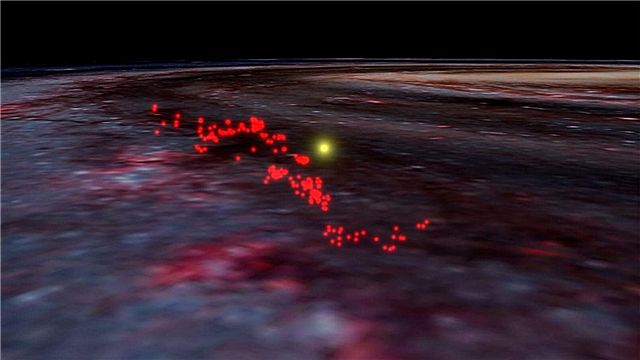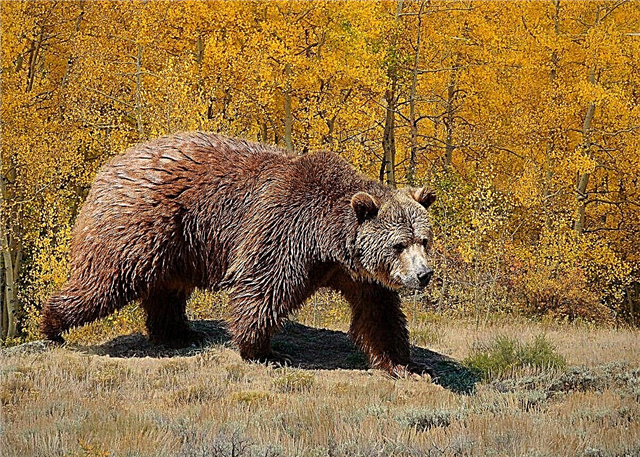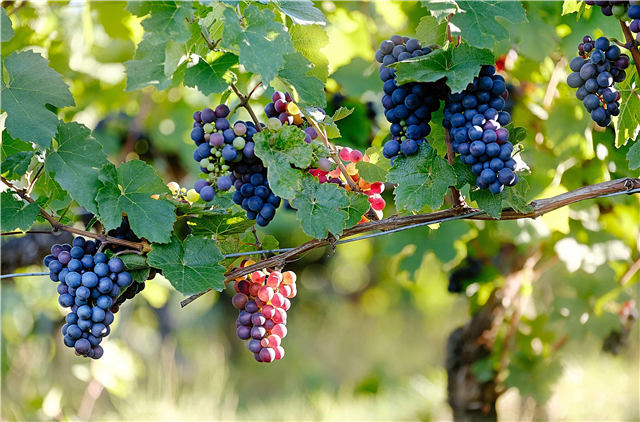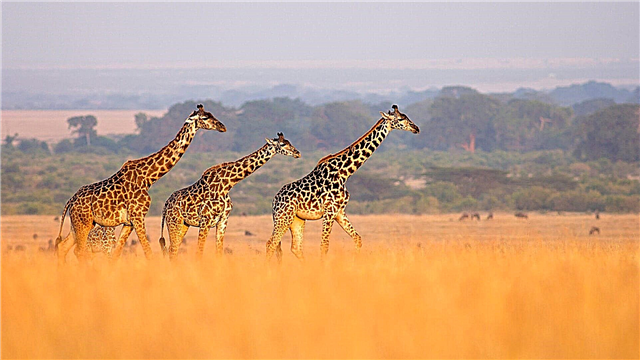
To spread their seeds as widely and further as possible, plants often use the help of animals. In others, including cultivated fruit trees, seeds are swallowed by carnivores and germinate after leaving the animal's body with excrement or burping.
However, seeds are not only distributed by vertebrates; the role of ants is also great in this.
Ants - seed distributors
Biologists are just beginning to understand the specialized mechanisms that put ants among the main factors in the spread of plants around the globe. Plants settled by ants are found in various ecosystems on all continents except Antarctica. Now more than 3000 species of flowering plants from 60 families are known, spreading in this way, and this list is all replenished.

Between plants and ants carrying their seeds, true mutualism is formed, i.e. mutually beneficial relations. Mutualism arose independently in so many groups of plants, which, apparently, we can speak of a strong selection pressure, which was repeatedly repeated during evolution, which contributed to its appearance. The process of natural selection associated with mutualism between plants and animals, the evolution of interspecific relationships of this kind and the environmental advantages created by them is dedicated to this article.
Mechanisms of seed distribution with the participation of ants
There are two different mechanisms for the distribution of plant seeds with the participation of ants. The first is due to the imperfect behavior of reaper ants, who collect seeds in large quantities and drag them into their nests, and then eat them. These insects lose some of their seeds along the way, and some of them are put into underground storage rooms, but then they do not visit them. Such seeds germinate and the plant appears in new places.
Since ants nevertheless eat more seeds than they drop or unsuccessfully hide, the described mechanism is much more beneficial for ants than for plants that lose the bulk of the seeds. Therefore, seed spacing by reaper ants should be attributed to side effects of seed nutrition, and not to mutualism. The effect of this mechanism is limited almost exclusively to arid regions.
Mirmekohoriya
We will be interested in the second mechanism of seed distribution, fundamentally different from the first and of much greater importance in nature. Plants participate in this mechanism, in which the so-called eliosomes develop - fat-containing formations adjacent to or attached to the seed. Eliosomes serve as a bait for ants, and they carry the seeds along with the eliosomes to their nest. There, the inhabitants of the colony eat the eliosome, and discard the seed without harming it.
At the same time, the plant does not have to sacrifice its seeds to feed the ants. Such relationships, called myrmecochoria (from the Greek “myrmex” - an ant and a “chorus” - advancing, spreading), can apparently be considered true mutualism, since they are beneficial both to ants dragging seeds and to plants forming eliosomes.
Eliosome Evolution
During evolution, eliosomes as bait for ants repeatedly appeared in various plant families. They are very common in the vegetation of the moist forests of Europe and eastern North America, the dry shrub communities of East Australia, and the plant communities in southern Africa.
Most often in the family, only some species are spread by ants. For example, in the enormous genus of Carex sedges, only a few species have eliosomes that provide, as has been shown, the spread of seeds by ants. Many other species of the same genus are settled using water or vertebrates.Among plants of the genus Trillium, which are distinguished by large flowers, in a number of species the seeds are equipped with eliosomes and spread by ants, while in other forms the fruits are fleshy and settlement occurs through vertebrates. These examples, taken from phylogenetically very distant groups, show that myrmecochoria can arise independently within a particular genus.
The spread of myrmecochoria
The first myrmecochoria was studied in detail by botanist Johan Rutger Cernander of Uppsala University in Sweden; in 1906, he published a review of myrmecochore plants of the European flora. Using a quantitative experimental approach, Cernander established the great importance of myrrh-mechoria for most European types of vegetation. The results of many of his field experiments with various plant species showed that, with the possibility of choice, ants prefer seeds with eliosomes.
Although the study of myrmecochora plants began in Europe, botanists soon examined the vegetation of other continents. Gradually, plants of North and South America were added to the list of myrmecochores. In Europe and North America, most of them are herbaceous plants of moist deciduous deciduous forests (Cernander was the first to notice this pattern). In Latin America, ants spread the seeds of many herbs, epiphytes, and vines of the tropical rain forest.
Mirmecochores are especially numerous in Australia and southern Africa, where they are mainly represented by hard-leaved shrubs growing on arid soils poor in nutrients. In 1975, R. Berg from the University of Oslo published the results of his research, according to which in Australia about 1.5 thousand species from 87 genera of plants are distributed with the participation of ants. In the specific plant communities of South Africa, called “finbosh”, there are more than a thousand species of myrmecochor species. The ongoing studies of the living world of the tropics will undoubtedly significantly replenish this list.
Diversity of eliosomes

The taxonomic diversity of plants with eliosomes corresponds to the widest assortment of plant tissues that have turned into structures for attracting ants. In a number of species, for example, Dicentra cucullaria, an eliosome is formed from an overgrown portion of the seed coat. In other species, in particular in spring-blooming liverworts growing in eastern North America, eliosomes come from a part of the wall of the ovary surrounding the seed. In the Carex genus, zlyosomes arise from bract tissue that encircles the ovary. Cases are known when some other organs of flowering plants become eliosomes.
The diversity of the origin of eliosomes is a good example of convergent evolution, demonstrating how structures of various shapes and functions can be transformed in the process of natural selection and acquire the same purpose from an environmental point of view. In the case of eliosomes, plant tissues that initially played the role of protection against phytophage insects or other factors, having undergone biochemical and structural changes, turned into food baits for ants.
The composition of the eliosome
Eliosomes are made up of highly mutated cells containing large vacuoles - membrane-enclosed cavities filled with a mixture of various nutrients. Having studied a wide range of myrmecochore plants, A. Brzezinski from the University of Munich established that the eliosomes contain a rich set of fats, fatty acids and other substances necessary for animals. So ants can use eliosomes as food.
Most ants are omnivorous: they eat insects and various plant and animal material found on the surface of the soil. Eliosomes and seeds attached to them must chemically mimic animal tissue, which causes ants to grab them.
Food bait for ants
Eliosomes may also include other chemical components that cause foraging behavioral reactions of ants. D. Marshall of the University of New Mexico and her colleagues isolated a specific substance, the polar lipid 1,2-diolein, which is an attractant for ants, from the eliosomes of European fragrant violet (Viola odorala). A similar compound was found in the eliosomes of two Australian shrubs - Acacia myrtifolia and Teratheca stenocarpa.
The value of these substances for ants is not yet completely clear, but their presence in myrrh-mechor plants on opposite sides of the globe suggests that there has been convergent evolution. In addition, this similarity suggests an interesting assumption that eliosomes can cause ants not only to collect food, but also other congenital behaviors. So, it is known that oleic acid induces some ants to remove dead animals from the nest. It is possible that eliosomes containing this substance are carried away by ants for the same reason.
Effective seed distribution in myrmecochores
In addition to food baits - eliosomes - myrmecochore plants sometimes also have other morphological devices that facilitate the entry of seeds into places visited by ants. In some plants, the stems and shoots bearing the fruits are so thin and flexible that when the seeds ripen, they bend almost to the ground, being in the way of foraging ants.
Other plants have undergone deeper morphological changes. For example, in the Carex umbellate sedge, the flower-bearing shoot is very shortened and the seeds (together with the tissues surrounding them) ripen on the ground itself, so that they always stay at the level where the ants are looking for their food.

Morphological changes in Trillium petiolatum, which grows in western North America, are even more pronounced. Most species of the genus Trillium have one flower and three leaves located on the top of a high (up to 30 cm) stem. And in Trillium petiolatum, a large, noticeable flower is formed very close to the ground, and there seeds that are equipped with eliosomes ripen in an accessible place for ants.
In addition, if Trillium petiolatum, like other species of the same genus, had leaves whorled under a flower, they would have appeared directly on the surface of the soil. However, in this species, although the leaves attach to the stem in the usual place, i.e. under the flower, leaf blades sit on the end of long petioles that lift the leaves above the flower so that they are more convenient for photosynthesis. In short, the typical “architecture” of the Trillium genus of the plant is reversed. In order to provide a reasonable evolutionary explanation for this form of T. petiolatum, it should be assumed that the distribution of seeds by ants provides enormous benefits.
For more efficient seed distribution in myrmecochores, their ripening times may also change. In temperate zones in most of these plants, seeds and eliosomes ripen in early spring. At this time, the corpses of insects, often forming the basis of the diet of ants, are much less common than in summer, when the number of insects increases many times. Thus, plants in which mature eliosomes appear in spring will experience less competition for the attention of foraging ants, and their seeds will be transported more often than in summer or autumn.
The predominance of spring Myrmecochores can be explained by the action of natural selection, which favored the early ripening of seeds and eliosomes. Of course, other factors can also contribute to the high metabolic rate of forest herbaceous plants in early spring - in particular, the abundance of sunlight at the ground level before the tree crowns open. It is possible that the peculiarities of ants foraging constitute only an additional factor of selection pressure, enhancing the development of myrmecochora plants in early spring.
Ants picking seeds

The ants collecting seeds make up a rather “motley” group. Many of them, judging by a number of signs, obviously should be carnivorous. K. Horwitz from the University of Miami showed, for example, that in the south of Mexico Calathea seeds are carried by ants from the genera Odontomachus and Pachyeondyla, which have powerful stings and large mandibles to cope with live prey.
Nevertheless, these ants very actively collect seeds and carry them to their nest, where they separate the eliosomes from the seeds and feed them to the larvae. It may turn out that some chemical compounds contained in the eliosomes are the same stimulus for ants as they possess.
Types of Ants Spreading Seeds
Seeds are spread and representatives of many other genera. In the forests of the temperate zone of Europe and North America, these are usually Formica, Myrmica, and Aphaenogaster, and on species of southeast Australia the species of the genera Rhyti-doponera, Pheidole, and Iridomyrmex play the most prominent role. Even such typically grain-eating reaper ants as Messor, Pogonomyrmex and yeromessor, under certain conditions, as it turned out, serve as carriers of seeds.
With the myrrh-mechor method of plant settlement, the direct sense is to attract as many different ants as possible. As a rule, quite a few species of ants are found in the same place, so if a plant has a method of attracting only one of them, it clearly loses many benefits. In fact, among the thousands of world-famous plant-bearing species of plants known to science, there is not a single one about which it would be safe to say that it is oriented to any one pitchfork of ants.
Similarly, there is no evidence of the specialization of any species of ants to one particular species of myrmecochor plant. This lack of specialization contrasts sharply with the widespread species-specificity of the relationship between insects and plants in the tropics, which is often of great importance for pollination. In this regard, the phenomenon of myrmecochoria should be considered the result of the evolution of plants, and not the co-evolution of plants and insects. From the “point of view” of the ants, the eliosome must be the same food that should be brought home, only in a special package.
Why exactly do ants spread seeds?
After all, where myrmecochores grow, as a rule, representatives of many other groups of insects are also found. However, in order to ensure effective plant propagation, insects are required that move seeds over a considerable distance without damaging them. This requirement is met only by social insects, which carry food in their nest, and do not eat it on the spot. Typically, working individuals examine and pluck some territory around the nest (anthill), and then drag everything edible there to feed the larvae. That is why the evolution of social behavior among ants preadapted them (that is, made them suitable in advance) for the effective distribution of seeds.
Ants also have other characteristics suitable for the role of seed distributors. In most habitats, ants belong to the most numerous insects; they intensively search for food on the surface of the soil throughout the entire growing season of plants; Having discovered a new source of food, the ants mobilize other working individuals to collect as much feed as possible; if there is a place, especially rich in food, they can even move there with the whole nest. All these behaviors are beneficial to myrrh-like plants seeking to distribute their seeds.
Since myrmecochoria is found all over the world in a wide variety of habitats, ecologists have wondered if there are any common patterns in the evolutionary advantages obtained by plants due to this phenomenon. And recently, a number of field and laboratory experiments have revealed how the attractiveness of seeds for ants increases the survival and fecundity of myrmecochor plant species.
The benefits for plants from the spread of seeds by ants
Extending the boundaries of the range is the main benefit for the plant from the spread of seeds by ants. Often ants carry seeds only a meter or two, but movements are recorded at a distance of 70 m.So thanks to ants, plants get the opportunity to populate new territories. The dispersal of a population reduces the likelihood of its extinction due to local changes in habitat. Any kind of ants can provide this advantage regardless of its nest-building habits.
Thanks to ants, the chances of seed survival may also increase, since they are carried away from the parent plant and its shadow will not inhibit the development of seedlings. One of the authors of the study, namely Handle, conducted the following experiment. The seeds of the Carex peduncula sediment (a, left under the parent plant, gave seedlings with only three leaves, and from the seeds removed from under it, seedlings developed with an average of 89 leaves at the same time. Moreover, the seeds moved were much more prolific: only they gave plants that bloomed the very next summer.
The movement of seeds by ants reduces competition not only between seedlings and the mother plant, but also between plants of different species. So, in Handle’s experiments with three species of Carex (of which one was a Mirmekohor), which grew in one habitat, the presence of other sedges interfered with the Myrmecohor species, and it only grew well apart.
Since local ants were only interested in seeds with eliosomes, they naturally took the seeds of Mirmekochor sedge into their nests. Due to this, the myrmechor species was able to monopolize in those habitats those areas where there were many anthills (for example, in rotten wood). Here he did not have to compete with other Carex species for space, light, nutrients and other basic resources. Mirmekohoriya would be effective in the presence of representatives of many other genera, the seedlings of which compete for a "place in the sun."
Even greater losses than from competition, seeds and seedlings are caused by eating them by animals, in particular birds and small rodents, for which seeds form the basis of the diet. In addition, as any gardener knows, snails and slugs also destroy seedlings.
In a number of regions of the globe, the possibility has been studied that the presence of seeds in anthills protects them from being eaten by at least some granivorous animals. According to studies conducted in the forests of West Virginia and in subalpine meadows pcs. Colorado seeds placed on small platforms, protected from the penetration of ants, almost inevitably were eaten during the day. If the ants were not blocked, the seeds with eliosomes quickly fell into their underground storages. Turnbell from Macquarie University in Australia showed that in Viola nuttallii, growing in Colorado, the seasonal and daily dynamics of seed release correspond to periods of maximum ant activity.
Perhaps the most interesting situation is the eating of seeds in heather communities and woodlands of Australia, where the dominant vegetation element is hard-leaved shrubs (sclerophylls), and myrmecochor pitchforks are quite numerous, as are granivorous animals. It is ironic that the main grain-eating species here are ants. Judging by the results of one of the latest works by L. Hughes (also from Macquarie University), in such a community the fate of a fallen seed depends on who first finds it - a “useful” ant that transfers seeds, or “harmful” that eats them. If the seed has an eliosome, then it is more likely that the “useful” ant will pick it up before the “harmful" one.
Another threat is fires. Especially great is their role in Australian and South African ecosystems with a predominance of shrubs. However, plants of these communities have a number of adaptations for surviving fires. Many species, including some myrmecochores, are not only resistant to fire, but need fires for their reproduction.
The data obtained by a number of Australian researchers convincingly indicate that moving to the nests of ants protects the seeds from lethal overheating during fires in shrub communities. But some of the seeds carried by ants are not able to germinate without a specific sublethal heating. Excavations of anthills showed that the seeds are buried at different depths. Such an arrangement in the “granaries” is probably beneficial to plants, because thanks to this, seeds that have not experienced fatal overheating, but heated enough to germinate, are likely to remain in some of the layers.
The influence of ants on the environmental conditions for the development of seedlings
Unlike birds and mammals, scattering seeds that came to them almost randomly throughout the territory, ants carry them to strictly defined places in their colony; this behavioral trait also improves seed survival. So, in moderately humid forests, ants often nest in rotting trunks and stumps that rise above ground level. Such places are less prone to flooding during spring floods and are therefore very convenient for both ants and seeds.
As in any other animal (and human) community, garbage accumulates in the ant colony. Ant "garbage dumps" contain the remains of prey, excrement, the bodies of dead individuals and a lot of other material (which is sometimes impossible to guess about the purpose), which ants pick up and invariably drag home. For sprouting seeds and seedlings, especially myrmecochore species, getting to a landfill like this can be very useful.
Organic waste is often rich in nutrients necessary for plant growth (therefore gardeners arrange compost heaps, and farmers bring manure into the soil of plantations). In the nests of ants, the concentration of organic matter, nitrogen, potassium and phosphorus is often higher than in the surrounding soil. Thus, the scum of an ant colony can provide seedlings with a small, but ready-to-eat, supply of compost, which is so necessary for the plant in the early stages of development, which are especially sensitive to environmental conditions.
The survival of the seedlings is also facilitated by the physical properties of the soil on which the ant nest is located, and the neighboring areas. The construction of the anthill often makes the soil more loose and better aerated, increases its ability to retain water. According to some researchers, the main thing that gives the plant an anthill is the receipt of the necessary amount of water to the seedling at a time when its roots are still too small to independently provide water to the plant.
Experiments to assess the role of myrmecochoria
So, it is clear that ants can significantly affect the environmental conditions for the development of seedlings. In order to evaluate the role of myrrh-mechoria in evolution, field experiments were carried out in which the fate of two groups of seeds was traced and compared: some seeds were carried away to the nest by ants, and others were manually sown in the same habitat. Among the first experiments of this kind were studied two myrmecochor species of violets in the south of England. After 3 years, when the seeds sprouted and seedlings appeared, it turned out that all the surviving plants belonged exclusively to the group that passed through the anthill.
A similar experiment was done with a two-year-old plant, Corydalis aurea, which produces seeds in the second year. F. Hanzawa of Grinnel College found that the survival rate of seedlings that sprouted on and outside the anthills is the same. However, among the seedlings of the first group, the proportion of survivors of winter and reaching reproductive age was higher.This led to the fact that in the next generation the difference in the total number of seeds formed by plants of the first and second groups turned out to be very significant: the seed yield from plants that passed through the anthill turned out to be twice as much as in the control group.
Since in the first generation the number of seeds in different groups was exactly the same, it is obvious that the population of gold crested, exploited by ants, will grow much faster than in the absence of ants. A rapidly growing population is more likely to win competition with other plants for nutrients, living space and other resources. Thus, the Hanzawa data suggest that the environmental conditions of seed distribution, including the presence of ants, influence the evolutionary potential of plant populations.
Therefore, myrmecochoria undoubtedly gives a number of advantages to certain plant species. But it has not yet been established with certainty what exactly the ants win in the process of this interaction. Say, it is known that foraging ants actively seek out eliosomes, quickly gnaw them away from seeds and feed them to larvae. But how this behavior affects the growth rate of an ant colony remains to be seen.
Noteworthy is the fact that not all ants are involved in the distribution of seeds. When seeds are showered from a plant, only a small fraction of the many species of ants inhabiting a given habitat show interest in eliosomes. There must be a certain specialization among ants, but it is still not known what its nature is - behavioral, morphological, food or some other.
That is why the distribution of seeds by ants can be considered an important model for studying a wide range of interactions between plants and animals, which in a certain sense seem to be asymmetric. Plants clearly developed special adaptations to deal with ants (the most noticeable among adaptive characters are eliosomes), but what the adaptations acquired by ants consist in is far from obvious.
Although myrmecochoria justifies itself as a mechanism of seed distribution, at the same time it is not completely reliable. Eliosomes are attractive to ants of various groups. However, as shown by experiments with the golden Corydalis, seedlings never appear in the nests of some species of ants. Apparently, these ants use the eliosomes for free, probably destroying the seeds attached to them, or seedlings.
In addition to such robber ants, in any habitat there are about a dozen other factors affecting the success or failure of myrmecochoria as a mechanism for seed distribution. Sometimes the dwellings of ants are flooded by rains; fungal epizootics or violent activity of predators can undermine their population. With an abundance of other food sources, eliosomes may not be as attractive to ants. If several species of plants have to compete for service by their ants, the latter may neglect seeds with the smallest eliosomes.
Mirmekohoriya - conditional mutualism

Since the efficiency of seed distribution by ants varies widely, X. Cashman from Macquarie University and J. Eddicott from Prov. Alberta (Canada) suggested that myrmecohoria is conditional mutualism. At one time or another in a given place, this mechanism, depending on the prevailing conditions, may not work very effectively.
However, if all conditions are met, the benefits of myrmecochoria for both plants and ants are very significant. And these benefits are so great that the pressure of selection retains the attributes necessary to maintain appropriate types of behavior.
As soon as the list of known myrrh-mechor plants grows all the time, it is hoped that knowledge about the role of this mechanism of plant settlement in the global biota will expand. Further studies of the benefits created by myrmecochoria to plants and ants will also help clarify the mutualistic relationships and their evolutionary consequences.












